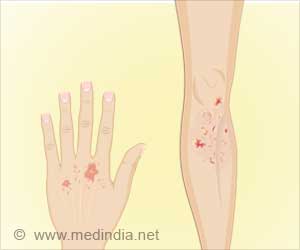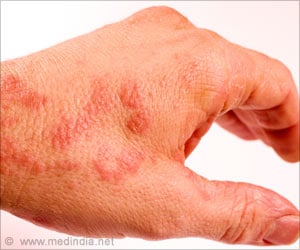There might be more than what meets the eye with the skin of children who suffer from both atopic dermatitis/eczema and food allergy, finds a new study.

‘With the help of this study, researchers understood how healthy-looking skin might be different in children who develop both eczema and food allergy compared to children with eczema alone
’





Scientists have now found that children with both atopic dermatitis and food allergy have structural and molecular differences in the top layers of healthy-looking skin near the eczema lesions, whereas children with atopic dermatitis alone do not.Defining these differences may help identify children at elevated risk for developing food allergies, according to research published online today in Science Translational Medicine. The study was supported by the National Institute of Allergy and Infectious Diseases (NIAID), part of the National Institutes of Health.
"Children and families affected by food allergies must constantly guard against accidental exposure to foods that could cause life-threatening allergic reactions," said NIAID Director Anthony S. Fauci, M.D. "Eczema is a risk factor for developing food allergies, and thus early intervention to protect the skin may be one key to preventing food allergy."
Children with atopic dermatitis develop patches of dry, itchy, scaly skin caused by allergic inflammation. Atopic dermatitis symptoms range from minor itchiness to extreme discomfort that can disrupt a child's sleep and can lead to recurrent infections in scratched, broken skin.
The study, led by Donald Y.M. Leung, M.D., Ph.D., of National Jewish Health in Denver, examined the top layers of the skin, known as the stratum corneum, in areas with eczema lesions and adjacent normal-looking skin. The study enrolled 62 children aged 4 to 17 who either had atopic dermatitis and peanut allergy, atopic dermatitis and no evidence of any food allergy, or neither condition.
Advertisement
Researchers found that the skin rash of children with both atopic dermatitis and food allergy was indistinguishable from the skin rash of children with atopic dermatitis alone. However, they found significant differences in the structure and molecular composition of the top layer of non-lesional, healthy-appearing skin between children with atopic dermatitis and food allergy compared with children with atopic dermatitis alone.
Advertisement
"Our team sought to understand how healthy-looking skin might be different in children who develop both atopic dermatitis and food allergy compared to children with atopic dermatitis alone," said Dr. Leung. "Interestingly, we found those differences not within the skin rash but in samples of seemingly unaffected skin inches away. These insights may help us not only better understand atopic dermatitis, but also identify children most at risk for developing food allergies before they develop an overt skin rash and, eventually, fine-tune prevention strategies, so fewer children are affected."
Allergy experts consider atopic dermatitis to be an early step in the so-called "atopic march," a common clinical progression found in some children in which atopic dermatitis progresses to food allergies and, sometimes, to respiratory allergies and allergic asthma. Many immunologists hypothesize that food allergens may reach immune cells more efficiently through a dysfunctional skin barrier affected by atopic dermatitis, thereby setting off biological processes that result in food allergies.
Source-Eurekalert














